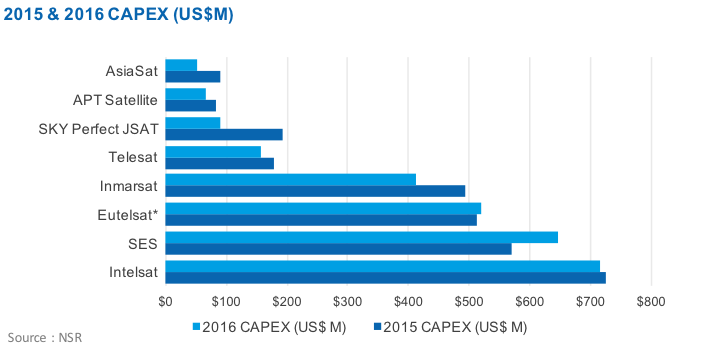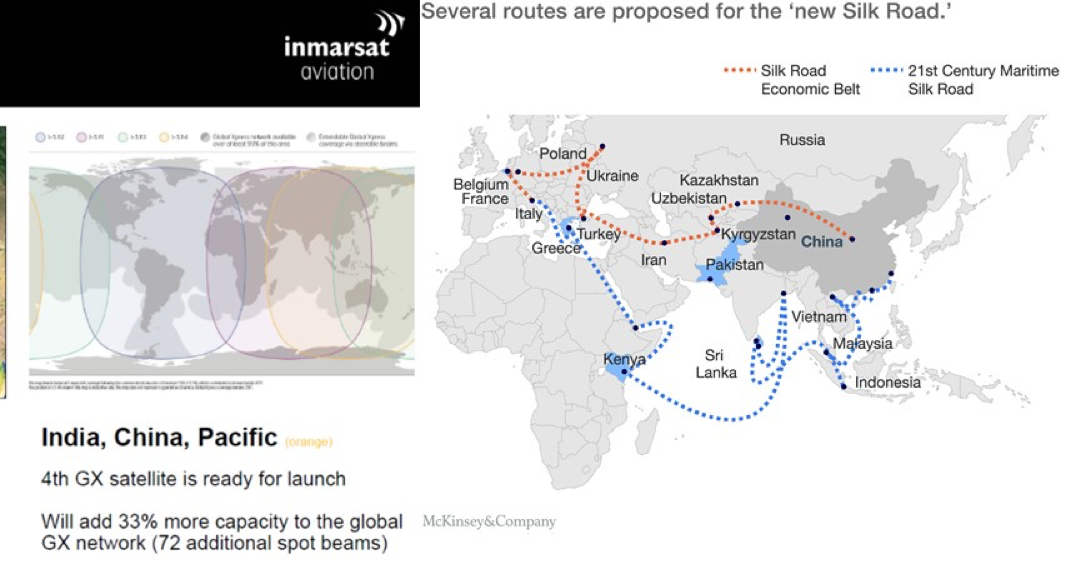Asian Satellite Market Update
May 17th, 2017 by
Blaine Curcio, NSR
This week saw the successful
launch of the fourth Inmarsat Global
Xpress satellite. This launch was noteworthy because the
company, by virtue of successfully launching the first three,
has already achieved global HTS coverage. The coverage of the
fourth—planned to address areas of high demand—has been a
topic of much speculation over the past year or more,
with Inmarsat CEO Rupert Pearce
 noting
last week that the satellite could potentially see its mission
changed during its in-orbit life, but that it will initially be
placed over Europe, Middle East, and Africa. As discussed in
NSR’s Satellite Operator Financial Analysis, 7th
Edition, this is the continuation
of a period of elevated CAPEX for Inmarsat, with the company
expected to continue adding capacity in the form of its
Inmarsat-6 duo of satellites. As discussed in the SOFA-7 study,
the company was initially planning to launch the satellite over
APAC, but these plans changed markedly due to a combination of
geopolitics and market conditions that are coming to a head
today. noting
last week that the satellite could potentially see its mission
changed during its in-orbit life, but that it will initially be
placed over Europe, Middle East, and Africa. As discussed in
NSR’s Satellite Operator Financial Analysis, 7th
Edition, this is the continuation
of a period of elevated CAPEX for Inmarsat, with the company
expected to continue adding capacity in the form of its
Inmarsat-6 duo of satellites. As discussed in the SOFA-7 study,
the company was initially planning to launch the satellite over
APAC, but these plans changed markedly due to a combination of
geopolitics and market conditions that are coming to a head
today.
The Belt & Road
This is in fairly sharp contrast to late 2015, at which time
Inmarsat was welcoming Chinese President Xi Jinping to the
company’s offices in London, announcing the establishment of a
framework that could see a deal that was, at the time, rumored
at the time to be for 15-years and hundreds of millions of
dollars for a “New Silk Road” (also known as One Belt, One Road,
or OBOR) mobile communications agreement. Up to this point,
Inmarsat has been kept waiting for a windfall deal as part of
China’s $40 billion “New Silk Road” fund, or the $122 billion
pledged infrastructure investment at the recent Belt and Road
Forum in May 2017.

Which brings us back to Inmarsat’s successful launch of
Inmarsat 5F4 this week. It is reasonable for Inmarsat to assume
that mobility demands in greater APAC will grow at a robust
clip. The Belt and Road initiatives involve significant amounts
of trade via land, sea, and (to a much lesser extent), plane.
These are all verticals that Inmarsat with Global Xpress should
be particularly well-suited to address, with some of the
shipping routes at left showing the diversity of coverage
required. The question, therefore, is what has kept Inmarsat
from following through on its initial plan to launch the 4th
Global Xpress satellite over Asia? The company has, as recently
as earlier this year, shown in presentations an APAC-centric
coverage map for the 4th satellite, such as the map
at right, and it is therefore somewhat surprising they would
decide to launch the 4th satellite initially over
EMEA, even if, up to this point, the company is seen as having
done quite well in these markets with GX. In light of recent
industry and macroeconomic events, however, the move makes
somewhat more sense, and may not bode well for Inmarsat.
Inside the Mind of the Politburo
There are two major factors here that ultimately may be
working against Inmarsat, if the medium-term intention is in
fact to move the satellite over APAC and address mobility demand
related to OBOR and/or the region’s IFC markets. These two
factors are 1) China’s push towards handling ever-more-complex
space matters domestically, and 2) China’s push towards
exporting high-tech goods and services in the future. In short,
space is sexy in China today, and the country’s government sees
a strong space program as a combination of supporting
technological leadership in a key industry and slick party
propaganda, with a strong/strengthening space program playing
into the greater narrative of a strong/strengthening China. The
country is therefore pushing towards developing more
space/satellite capabilities domestically, with this including,
but not limited to, the nation’s first HTS launch earlier this
year, the nation’s first sale of an HTS to a foreign customer
(Thaicom) in late 2016, and the nation’s first apparent
“OBOR-related” satellite sale with a potential 2x deal with
Indonesia earlier this month.
Beyond the above-mentioned “firsts”, China has seen several
domestic players make moves to address the mobility markets via
GEO-HTS, with some of the plays looking similar (albeit less
local) than Inmarsat’s. This includes APT Satellite’s
Ku-band GEO-HTS system, which is initially planned to
be one satellite targeting APAC (Apstar-6D, for launch in 2019),
and potentially several more aiming for global coverage. As
discussed in NSR’s SOFA7, APT Satellite is in excellent
financial condition given its low degree of leverage, and thus
would be likely capable of pursuing a program should demand
prove to materialize. Overall, the implication here is that
China is likely to prioritize domestic capacity for its
mobility needs, with this already being the case in
video broadcast, VSAT networking, and any other verticals that
ChinaSat (and to some extent APT Satellite) is able to serve.
The Impact on Greater APAC Supply
Perhaps more significant, however, is the potential impact on
the overall APAC supply/demand balance. Ultimately, it appears
that satellites for “broadband connectivity” purposes have in
many instances become a politically acceptable way of spending
infrastructure/R&D funds, and China has recognized that there is
a market here, even more so if Chinese Ex/Im-type loans are
oftentimes paying for these satellites, backed by natural
resources or some other tangible good. This could
radically alter the supply picture in Asia-Pacific,
with the recently announced satellites over Indonesia claiming
over 100 Gbps of capacity, according to a presentation at the
recent APSAT conference.

This capacity is oftentimes country-focused, or at most
region-focused, but the impact on supply/demand balances within
these countries or regions can be significant. Conservatively
speaking, total GEO-HTS Ka-band supply over APAC will reach 900
Gbps by the end of the decade, though with much of this being
government-launched satellites, including NBN (160
Gbps). While demand may be robust when considering
government-mandated programs with subsequent government funding,
this funding will also factor in on the supply side, with
countries like Myanmar and Bangladesh being involved in various
stages of satellite programs. Ultimately, operators will
need to find some way of differentiating their capacity
in a market that is becoming increasingly crowded, with some of
the entrants not playing purely for profit.
Bottom Line
The launch of the 4th Inmarsat Global Xpress
satellite occurred at a very busy time for the satellite
industry in Asia Pacific. Late 2016/2017 has already seen the
order of JSAT-18/Kacific, the purchase by Thaicom of an HTS on
behalf of a client, the firm purchases for national
satellites/private-public-partnership schemes for Indonesia, and
the first HTS launch for China (with another planned next week,
with 70 Gbps of capacity). In addition to this, we saw just last
week the involvement of Sky Perfect JSAT in LeoSat’s
constellation plans with an investment of $100M. What is more,
SoftBank of Japan is undoubtedly the industry’s biggest investor
as of late, with a $1B+ investment into OneWeb, and a potential
$1.7 billion on the table as a proposed investment into
Intelsat.
Inmarsat’s 4th GX satellite is likely to remain
over EMEA until the company obtains some bulk lease within
APAC/China, along the lines of the rumored government contract
linked above. Given the increasing tendency for China to launch
higher throughput capacity—and to finance other countries in
APAC to do the same—it may be more difficult than
originally assumed to find a lease that would justify
such a move. In an industry known to be fairly stable, the
satellite telecommunications industry in Asia is more volatile
than ever today.
|
|